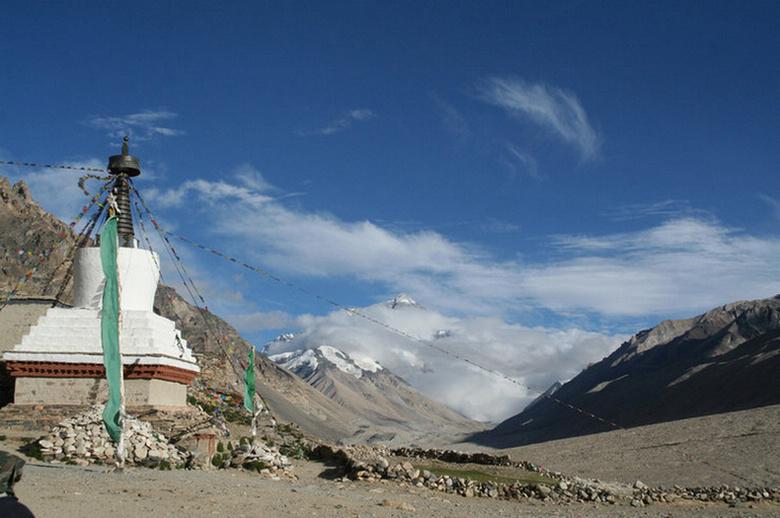
Overview
The Everest, Quomolangma in Tibetan, can be interpreted as ' Goddess Mother of the Universe' ("Sagarmatha' in Nepali). According to Tibetan scriptures safeguarded at Rongpu Monastery Quomolangma is the name of the mountain while the goddess who dwells there is called Miyo Langsangma.
Located in bordering areas with Nepal in Tingri County, it is 8,848.13 meters high, the tallest mountain in the world. In the area of 5,000 square kilometers around the mountain, there are four peaks being more than 8,000 meters high and 38 peaks being more than 7,000 meters high. Thus it is reputed as the Third Pole on the Earth.
At the foot of Mt. Qomolangma or 40 kilometers away stands the Rongpu Monastery, with the highest elevation in the world. The monastery has become a camp of mountaineers form northern slope to Mt. Qomolangma.
Know more
Story of Mt. Quomolangma
In 1849 the Great Trigonometrical Survey of India mapped the heights of peaks in the Himalaya range. The calculations were carried out from the Indian foothills of the Himalaya, and three years later the computed results showed a peak, known to the West as peak XV, to be the highest mountain in the world. This came as surprise, as until this time a mountain called Kanchenjunga near Sikkim was thought to be the peak whose head rose closest to the heavens. Peak XV was rather an ignominious name for the highest mountain in the world, and immediately a search began for its real name.
Western linguists working in Nepal and India reported various local names for the mountain. In Nepal, it was claimed, XV was known as Devadhunga (Abode of the Gods). German explorers, on the other hand, reported that the Tibetan name was Quomolangma. In 1962 the Royal Geographic Society opted for an alternative Nepali name for the mountain: Gaurisanka.
The Everest name stuck amid much controversy, not least due to the fact there were probably no shortage of experts who knew the true Tibetan name for the mountain to be Chomolangma (or Quomolangma, as the Chinese have transliterated it).. As early as 1733, the French produced a map on which Everest is indicated as Tschoumou Lancma.
Quomolangma can be interpreted as Goddess Mother of the Universe' ('Sagarmatha' in Nepali). According to Tibetan scriptures safeguarded at Rongphu Monastery Quomotangma is the name of the mountain while the Goddess who dwells there is called Miyo Langsangma. She is one of a group of five well-known long-lived sisters called the Tsering Che Nga, Tibetan deities who predate Buddhism.
Trekkers who make it up to Everest Base Camp have to make do with a posed photograph in front of a sign inscribed with the words ' Mt Quomolangma Base Camp'.
Must see
Rongpu Monastery

Although there were probably monastic settlements in the area for several hundred years, Rongpu Monastery is the main Buddhist centre in the valley and once coordinated the activeities of around one dozen smaller religious institutions. It was established in 1902 by a Nyingmapa Lama.
While not of great antiquity, Rongpu can at least lay claim to being the highest monastery in Tibet and thus the world. Renovation work has been ongoing at the monastery since 1983, and some of the interior murals are absolutely stunning. The monastery itself makes fabulous photograph with Quomolangma thrusting its head skyward in the background.
